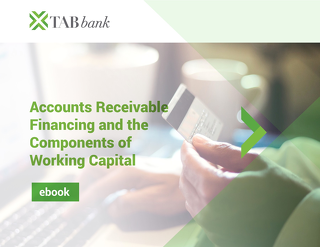Get Cash Flowing with Accounts Receivable Financing from TAB Bank
Turn your outstanding invoices into cash flow for your business.

Being tight on cash can make or break your business. Cash flow problems are common in businesses that have peak seasons and therefore slow seasons, or businesses that have large gaps of time between when a service or product is provided and when it is paid for. If your business experiences seasonality or has a long collection period, discover how TAB Bank could help with an accounts receivable financing solution.
What is Accounts Receivable Financing?
In today’s world, getting a business line of credit or loan isn’t always an option for some companies. Accounts receivable financing can offer you an alternative.
Accounts receivable financing, or AR financing for short, is for businesses who need working capital and have outstanding invoices from their clients. These outstanding invoices can be used as collateral for an immediately available line of credit.
Bottom line: you have earned revenue (receivables) but it’s taking too much time to get paid, and you have business costs today. If this sounds familiar to you, an accounts receivable financing loan may be the answer you need. AR financing can help you access the capital you need to focus on stabilizing, organizing, and even growing your business.
How Does Accounts Receivable Financing Work?
Accounts receivable financing is one of the most flexible products available for business financing. This type of financing provides you with immediate cash to help you grow your business and manage time-sensitive needs such as capitalizing on supplier discounts, hiring more employees, and even making payroll.
In simplest terms, accounts receivable financing allows businesses to use their unpaid invoices as collateral against a line of credit. TAB provides advances against a percentage of those invoices. As sales increase, so does the availability of funds for your company.
How Does Accounts Receivable Financing Provide Short Term Funding?
Accounts receivable financing is an effective way to receive payment quickly from unpaid invoices, even when industry standards mean you may normally have to wait as long as 90 days.
For example, you issue an invoice to XYZ, INC on April 1. Without accounts receivable financing in place, you may not see money from that invoice until June 30. With accounts receivable financing, TAB Bank pays you an advance upfront (as quick as 24 hours), giving you immediate access to the cash you need for operations and growth.
When the time comes to collect payment on the invoice, TAB handles the entire process and sends you any remaining amount due.
The Pros and Cons of Accounts Receivable Financing
Like any coin, or any financing option, there are two sides to accounts receivable financing. Here’s a quick look at the pros and cons you should consider:
Pros
You retain ownership of your own business:
You are your business. With accounts receivable financing you don’t sign over any portion of the ownership.
Immediate cash flow:
You get an immediate line of credit while we hold the unpaid invoices as collateral.
Cons
Cost:
Accounts receivable financing has an administration fee and sometimes a higher APR than other financing options.

What Type of Receivables Are Eligible for AR Financing?
Eligibility of your receivables is not a cut and dry decision. Your team at TAB Bank will review your receivables and consider some of these questions to determine eligibility of accounts receivable financing and how much of an advance is to be given.
Rates of the cash advance generally vary from 60%-90% of the value.
- How old are your unpaid invoices?
- What is the risk level of your customers?
- What is your business credit score?
- What is your personal credit score?
- What is your personal credit score?
- What is the size of your company?
Rates of the cash advance generally vary from 60%-90% of the value.
The Difference Between AR Financing and Factoring
Accounts receivable financing and factoring are both ways for small to midsize businesses to gain access to working capital based on the value of their outstanding accounts receivable invoices.
The main difference between AR financing and factoring lies within the ownership of the assets. AR financing uses the invoice as collateral on the loan, so the company still owns its AR assets. Factoring is the sale of the invoice to the factor (lender), so the ownership of the accounts receivable is turned over to the lender and the customer with an outstanding balance will then pay the lender the remaining amount due.
AR Financing Example
An example of AR financing is John, the owner of a mid-size manufacturing company. John’s company has recently delivered a large order to a wholesale client whose invoice is due in 90 days. However, John needs cash flow now for payroll, new materials, and shipping of other completed orders. John opts to utilize AR financing; he receives 65-80% of the value of the AR and is able to pay for the supplies he needs to continue operating efficiently. When the wholesaler pays off the invoice, John uses those funds to pay off the loan and the bank’s small service fee, and has credit available for use again in the future.
This process benefits John immensely, as the money he would lose waiting for the cash flow to buy new materials and pay his employees is far more than the administrative fee the bank charges for the AR financing service.
Reap the Benefits of Accounts Receivable Financing with TAB Bank
You’ve reviewed the pros and cons about receivables financing. Here’s why it benefits you to do it with TAB Bank:

Security
We provide you the security of a bank, and the flexibility and responsiveness of a financial corporation.
Accessibility
You’ll have access to our business and online banking tools to manage your credit anywhere, anytime.
Early Payment Discounts
You can get those “early bird” discounts with your suppliers because you have the capital readily available.

No Debt
Accounts receivable financing is not a loan, which will make it easier for your business to obtain financing in other ways.
Teamwork
Our relationship managers and treasury management experts work with you to align solutions with your business goals.
Volume Discounts
Having that flow of operating capital will ensure you can take advantage of bulk discounts offered by suppliers that you would otherwise be unable to afford.
Access to Reporting
Customer credit analysis and collections management will be provided to you.
Relationship
You’ll have a dedicated relationship manager available to help you with any questions or concerns along the way.
Company Growth
We’ll get you the cash flow so that you can focus on what you do best, growing your business.
Better Credit
A receivables line of credit will enable your business to pay bills and taxes in a timely manner; this will help your credit rating.
Continuous Flow of Operating Capital
No gaps in services or products provided on your end because of financial constraints, you can keep doing business as usual.
The Partnership You Didn’t Know You Needed
You don’t have to suffer through a tight spot alone. All businesses need help from time to time. Accounts receivable financing can be quick and painless and be just the boost you need to get through a bill cycle, or help you hire new staff to grow your business.
If this sounds like it might be right for you, give us a call at: 1-888-440-4541


